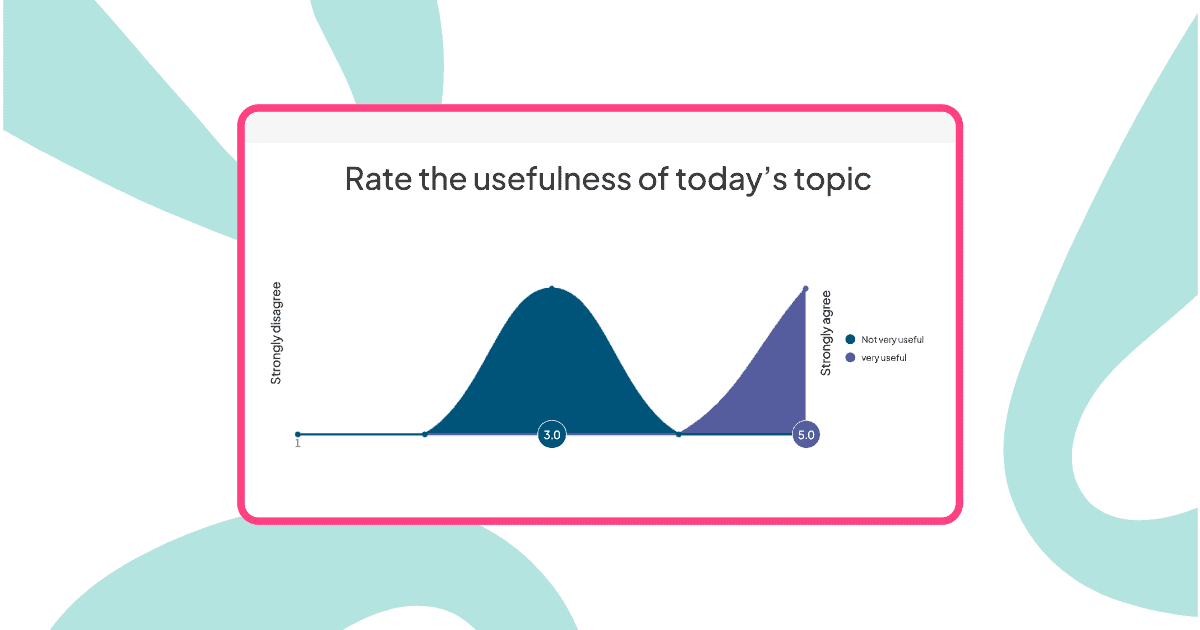آیا تا به حال به این فکر کردهاید که کارمندانتان واقعاً در مورد نقشها، مشارکتها و رضایت کلی شغلی خود چه احساسی دارند؟
یک شغل رضایتبخش دیگر محدود به حقوق آخر ماه نیست. در عصر دورکاری، ساعات کاری انعطافپذیر و نقشهای شغلی در حال تحول، تعریف رضایت شغلی به طرز چشمگیری تغییر کرده است.
مشکل اینجاست: نظرسنجیهای سالانه سنتی اغلب نرخ پاسخگویی پایینی دارند، بینشها با تأخیر ارائه میشوند و پاسخها سانسور میشوند. کارمندان آنها را به تنهایی پشت میزهای خود، جدا از لحظه و با ترس از شناسایی شدن، تکمیل میکنند. زمانی که نتایج را تجزیه و تحلیل میکنید، مشکلات یا تشدید شدهاند یا فراموش شدهاند.
یه راه بهتر هم هست. نظرسنجیهای تعاملی رضایت شغلی که در جلسات تیمی، جلسات شورای شهر یا جلسات آموزشی انجام میشوند، بازخوردهای معتبری را در لحظه ثبت میکنند - زمانی که مشارکت در بالاترین حد خود است و میتوانید به نگرانیها در لحظه رسیدگی کنید.
در این راهنما، ما ارائه خواهیم داد ۴۶ نمونه سوال برای پرسشنامه رضایت شغلی شما، به شما نشان میدهد که چگونه نظرسنجیهای ایستا را به گفتگوهای جذاب تبدیل کنید، و به شما کمک میکند فرهنگی در محل کار پرورش دهید که مشارکت کارکنان را پرورش میدهد، نوآوری را برمیانگیزد و زمینه را برای موفقیت پایدار فراهم میکند.
فهرست مندرجات
پرسشنامه رضایت شغلی چیست؟
پرسشنامه رضایت شغلی، که با نام نظرسنجی رضایت کارکنان نیز شناخته میشود، ابزاری استراتژیک است که توسط متخصصان منابع انسانی و رهبران سازمانها برای درک میزان رضایت کارکنانشان از نقشهایشان مورد استفاده قرار میگیرد.
این شامل سوالاتی با دقت طراحی شده است که برای پوشش حوزههای حیاتی از جمله محیط کار، مسئولیتهای شغلی، روابط با همکاران و سرپرستان، حقوق و دستمزد، فرصتهای رشد، رفاه و موارد دیگر طراحی شدهاند.
رویکرد سنتی: یک لینک نظرسنجی ارسال کنید، منتظر بمانید تا پاسخها به تدریج برسند، هفتهها بعد دادهها را تجزیه و تحلیل کنید، سپس تغییراتی را اعمال کنید که به نظر میرسد با دغدغههای اصلی ارتباطی ندارند.
رویکرد تعاملی: سوالات را به صورت زنده در طول جلسات ارائه دهید، از طریق نظرسنجیهای ناشناس و ابرهای کلمات، بازخورد فوری جمعآوری کنید، نتایج را به صورت بلادرنگ مورد بحث قرار دهید و در حالی که مکالمه تازه است، به طور مشترک راهحلهایی را توسعه دهید.
چرا پرسشنامه رضایت شغلی تهیه کنیم؟
تحقیقات پیو تأکید میکند که تقریباً ۳۹٪ از کارگران غیرخوداشتغال، شغل خود را برای هویت کلی خود بسیار مهم میدانند. این احساس تحت تأثیر عواملی مانند درآمد خانواده و تحصیلات شکل میگیرد، به طوری که ۴۷٪ از افراد با درآمد بالا و ۵۳٪ از افراد دارای تحصیلات تکمیلی، هویت شغلی خود را مهم میدانند. این تعامل برای رضایت کارکنان محوری است و یک پرسشنامه رضایت شغلی با ساختار مناسب را برای پرورش هدف و رفاه ضروری میکند.
انجام پرسشنامه رضایت شغلی مزایای قابل توجهی هم برای کارمندان و هم برای سازمان دارد:
درک عمیق
سوالات خاص، احساسات واقعی کارمندان را آشکار میکنند، نظرات، نگرانیها و حوزههای رضایت آنها را آشکار میکنند. وقتی این سوالات به صورت تعاملی و با گزینههای پاسخ ناشناس پرسیده شوند، شما از ترس شناسایی که اغلب منجر به بازخورد نادرست در نظرسنجیهای سنتی میشود، رهایی مییابید.
شناسایی مسئله
پرسشهای هدفمند، نقاط درد مؤثر بر روحیه و تعامل را مشخص میکنند - چه مربوط به ارتباطات، حجم کار یا فرصتهای رشد باشد. ابرهای کلمهای بلادرنگ میتوانند فوراً نقاطی را که اکثر کارمندان در آنها مشکل دارند، تجسم کنند.
راه حل های اختصاصی
بینشهای جمعآوریشده، امکان ارائه راهحلهای سفارشی را فراهم میکنند و تعهد شما را به بهبود شرایط کاری نشان میدهند. وقتی کارمندان میبینند که بازخوردشان بلافاصله نمایش داده میشود و بهطور آشکار مورد بحث قرار میگیرد، احساس میکنند که واقعاً شنیده شدهاند، نه اینکه فقط مورد نظرسنجی قرار گرفتهاند.
افزایش تعامل و حفظ مشتری
پرداختن به نگرانیها بر اساس نتایج پرسشنامه، تعامل را افزایش میدهد، به کاهش جابجایی کارکنان و افزایش وفاداری کمک میکند. نظرسنجیهای تعاملی، جمعآوری بازخورد را از یک کار اداری به یک گفتگوی معنادار تبدیل میکنند.
تفاوت بین نظرسنجیهای سنتی و تعاملی
| منظر | نظرسنجی سنتی | نظرسنجی تعاملی (AhaSlides) |
|---|---|---|
| تنظیم وقت | ارسال شده از طریق ایمیل، تکمیل شده به تنهایی | به صورت زنده در طول جلسات اجرا میشود |
| پاسخ داده شد | میانگین 30-40 درصد | ۸۵-۹۵٪ هنگام ارائه زنده |
| ناشناس | سوالبرانگیز - کارمندان نگران ردیابی هستند | ناشناس بودن واقعی بدون نیاز به ورود به سیستم |
| نامزدی | حس تکالیف مدرسه را دارد | حس مکالمه داره |
| نتایج | روزها یا هفتههای بعد | تجسم فوری و بلادرنگ |
| عمل | با تأخیر، قطع شده | بحث و راهحلهای فوری |
| قالب | فرمهای استاتیک | نظرسنجیهای پویا، ابرهای کلمات، پرسش و پاسخ، رتبهبندیها |
بینش کلیدی: وقتی بازخورد به جای مستندسازی، به شکل گفتگو باشد، افراد بیشتر درگیر میشوند.
۴۶ نمونه سوال برای پرسشنامه رضایت شغلی
در اینجا نمونه سوالات بر اساس دسته بندی مرتب شده اند. هر بخش شامل راهنمایی در مورد نحوه ارائه تعاملی آنها برای حداکثر صداقت و تعامل است.
محیط کار
سوالات:
- آسایش فیزیکی و ایمنی محیط کار خود را چگونه ارزیابی می کنید؟
- آیا از نظافت و نظم محل کار راضی هستید؟
- آیا احساس می کنید فضای اداری باعث ترویج فرهنگ کار مثبت می شود؟
- آیا ابزار و منابع لازم برای انجام کارتان به طور موثر فراهم شده است؟
رویکرد تعاملی با AhaSlides:
- از مقیاسهای رتبهبندی (۱ تا ۵ ستاره) که به صورت زنده نمایش داده میشوند استفاده کنید
- با یک ابر کلمه باز ادامه دهید: «در یک کلمه، فضای محل کار ما را توصیف کنید»
- حالت ناشناس را فعال کنید تا کارمندان صادقانه و بدون ترس شرایط فیزیکی را ارزیابی کنند.
- نمایش نتایج کلی بلافاصله برای شروع بحث
چرا این کار می کند: وقتی کارمندان میبینند که دیگران هم دغدغههای مشابهی دارند (مثلاً چندین نفر به «ابزارها و منابع» امتیاز ۲ از ۵ میدهند)، احساس میکنند که مورد تأیید قرار گرفتهاند و تمایل بیشتری برای توضیح بیشتر در جلسات پرسش و پاسخ بعدی دارند.
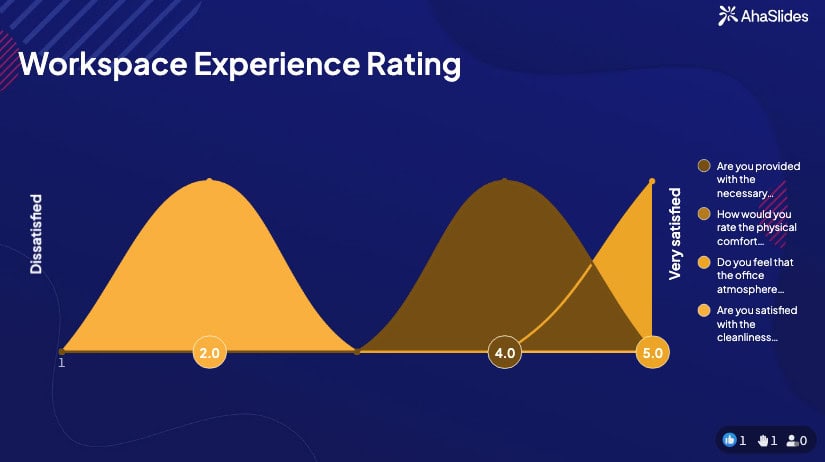
یک الگوی نظرسنجی محیط کار را امتحان کنید →
وظایف شغلی
سوالات:
- آیا مسئولیت های شغلی فعلی شما با مهارت ها و صلاحیت های شما همخوانی دارد؟
- آیا وظایف شما به وضوح تعریف شده و به شما ابلاغ شده است؟
- آیا فرصت هایی برای مقابله با چالش های جدید و گسترش مهارت های خود دارید؟
- آیا از تنوع و پیچیدگی کارهای روزانه خود راضی هستید؟
- آیا احساس میکنید شغلتان حس هدفمندی و رضایت را به شما میدهد؟
- آیا از سطح اختیارات تصمیم گیری که در نقش خود دارید راضی هستید؟
- آیا معتقدید که مسئولیتهای شغلی شما با اهداف و مأموریت کلی سازمان همسو است؟
- آیا دستورالعمل ها و انتظارات روشنی برای وظایف و پروژه های شغلی خود ارائه می کنید؟
- چقدر احساس می کنید که مسئولیت های شغلی شما به موفقیت و رشد شرکت کمک می کند؟
رویکرد تعاملی با AhaSlides:
- برای سوالات واضحتر، نظرسنجیهای بله/خیر ارائه دهید (مثلاً «آیا وظایف شما به وضوح تعریف شدهاند؟»)
- از مقیاسهای رتبهبندی برای سطوح رضایت استفاده کنید
- با پرسش و پاسخ آزاد ادامه دهید: «چه مسئولیتهایی را میخواهید اضافه یا حذف کنید؟»
- یک ابر کلمه ایجاد کنید: «نقش خود را در سه کلمه توصیف کنید»
نوک طرفدار: قابلیت پرسش و پاسخ ناشناس اینجا بسیار قدرتمند است. کارمندان میتوانند بدون ترس از شناسایی شدن، سوالاتی مانند «چرا در تصمیمگیری استقلال بیشتری نداریم؟» را مطرح کنند و به مدیران اجازه دهند تا به طور آشکار به مسائل سیستمی بپردازند.
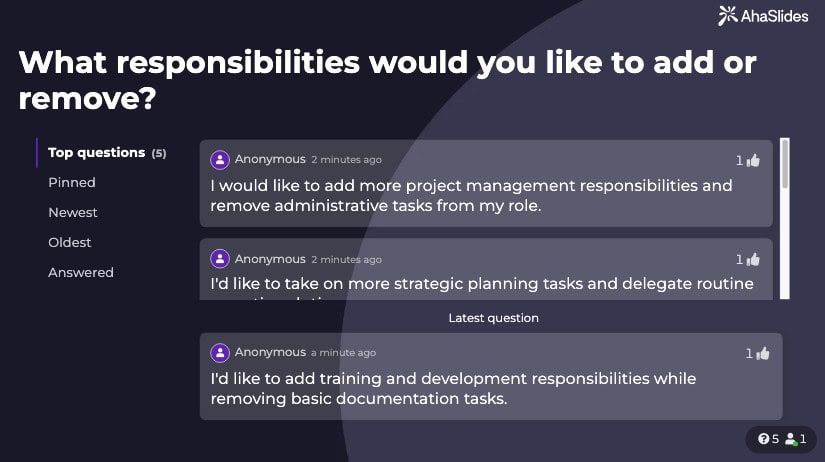
نظارت و رهبری
سوالات:
- کیفیت ارتباط بین شما و سرپرستتان را چگونه ارزیابی می کنید؟
- آیا در مورد عملکرد خود بازخورد و راهنمایی سازنده دریافت می کنید؟
- آیا تشویق می شوید که نظرات و پیشنهادات خود را به سرپرست خود بگویید؟
- آیا احساس میکنید که سرپرست شما برای مشارکتهای شما ارزش قائل است و تلاشهای شما را میشناسد؟
- آیا از سبک رهبری و رویکرد مدیریت در بخش خود راضی هستید؟
- به نظر شما کدام نوع از مهارتهای رهبری در تیم شما مؤثرتر خواهد بود؟
رویکرد تعاملی با AhaSlides:
- از مقیاسهای رتبهبندی ناشناس برای بازخورد حساس سرپرست استفاده کنید
- گزینههای سبک رهبری (دموکراتیک، مربیگری، تحولآفرین و غیره) را ارائه دهید و بپرسید که کارمندان کدام را ترجیح میدهند
- امکان پرسش و پاسخ زنده را فراهم کنید تا کارمندان بتوانند در مورد رویکرد مدیریت سؤال بپرسند.
- رتبهبندی ایجاد کنید: «چه چیزی در یک سرپرست برای شما بیشترین اهمیت را دارد؟» (ارتباطات، قدردانی، بازخورد، استقلال، حمایت)
چرا ناشناس بودن مهم است: طبق برگه ارزیابی جایگاه شما، متخصصان منابع انسانی باید «فضاهای امنی برای بحث صادقانه ایجاد کنند». نظرسنجیهای ناشناس تعاملی در جلسات شورای شهر به کارمندان این امکان را میدهد که رهبری را صادقانه و بدون نگرانیهای شغلی ارزیابی کنند - چیزی که نظرسنجیهای سنتی برای دستیابی به آن به طور قانعکنندهای تلاش میکنند.
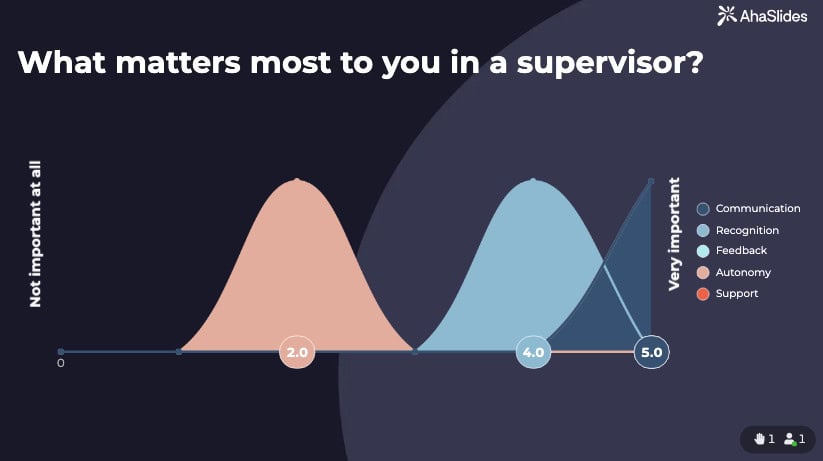
رشد و توسعه شغلی
سوالات:
- آیا فرصت هایی برای رشد و پیشرفت حرفه ای برای شما فراهم شده است؟
- میزان رضایت شما از برنامههای آموزشی و توسعهای ارائه شده توسط سازمان چقدر است؟
- آیا معتقدید که نقش فعلی شما با اهداف شغلی بلندمدت شما همسو است؟
- آیا به شما فرصتی داده می شود که نقش های رهبری یا پروژه های ویژه ای را بر عهده بگیرید؟
- آیا برای ادامه تحصیل یا ارتقای مهارت از شما حمایت می شود؟
رویکرد تعاملی با AhaSlides:
- نظرسنجی: «چه نوع توسعه حرفهای بیشترین سود را برای شما خواهد داشت؟» (آموزش رهبری، مهارتهای فنی، گواهینامهها، مربیگری، اقدامات جانبی)
- ابر کلمات: «خودت را در ۳ سال آینده کجا میبینی؟»
- مقیاس رتبهبندی: «چقدر در پیشرفت شغلی خود احساس حمایت میکنید؟» (1-10)
- پرسش و پاسخ آزاد برای کارمندان تا در مورد فرصتهای توسعه خاص سوال کنند
مزیت استراتژیک: برخلاف نظرسنجیهای سنتی که این دادهها در یک صفحه گسترده قرار میگیرند، ارائه سوالات مربوط به توسعه شغلی به صورت زنده در طول بررسیهای فصلی به منابع انسانی این امکان را میدهد که بلافاصله در حین گفتگو، در مورد بودجههای آموزشی، برنامههای مربیگری و فرصتهای جابجایی داخلی بحث کنند.
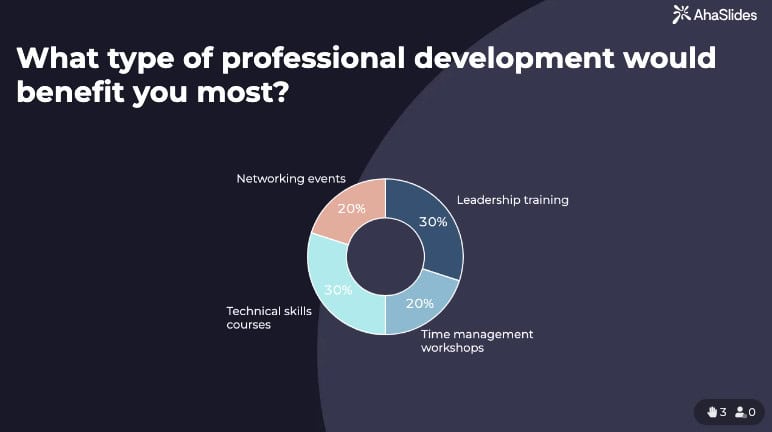
جبران خسارت و مزایا
سوالات:
- آیا از بسته حقوقی و غرامت فعلی خود از جمله مزایای جانبی راضی هستید؟
- آیا احساس می کنید که کمک ها و دستاوردهای شما به درستی پاداش می گیرد؟
- آیا مزایای ارائه شده توسط سازمان جامع و مناسب نیازهای شما هستند؟
- شفافیت و عادلانه بودن فرآیند ارزیابی عملکرد و جبران خسارت را چگونه ارزیابی می کنید؟
- آیا از فرصت های جوایز، مشوق ها یا پاداش ها راضی هستید؟
- آیا از سیاست مرخصی سالانه راضی هستید؟
رویکرد تعاملی با AhaSlides:
- نظرسنجیهای ناشناس بله/خیر برای سوالات حساس حقوق و دستمزد
- چند گزینهای: «کدام مزایا برای شما بیشترین اهمیت را دارد؟» (بهداشت و درمان، انعطافپذیری، بودجه آموزشی، برنامههای تندرستی، بازنشستگی)
- مقیاس رتبهبندی: «حقوق ما نسبت به مشارکت شما چقدر منصفانه است؟»
- ابر کلمات: «کدام مزیت بیشترین رضایت شما را افزایش میدهد؟»
نکته انتقادی: اینجاست که نظرسنجیهای تعاملی ناشناس واقعاً میدرخشند. کارمندان به ندرت در نظرسنجیهای سنتی که نیاز به اطلاعات ورود دارند، بازخورد صادقانهای در مورد حقوق و دستمزد ارائه میدهند. نظرسنجی ناشناس زنده در جلسات شورای شهر، که در آن پاسخها بدون نام نمایش داده میشوند، امنیت روانی برای بازخورد واقعی ایجاد میکند.
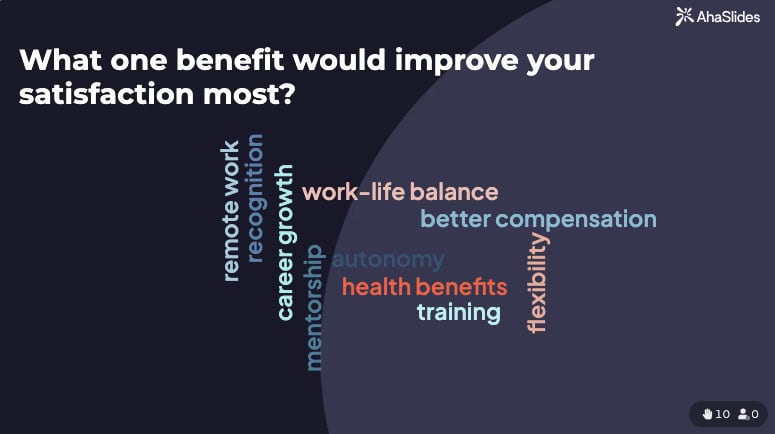
جلسه بازخورد جبران خسارت خود را ایجاد کنید →
روابط و همکاری
سوالات:
- چقدر با همکاران خود همکاری و ارتباط برقرار می کنید؟
- آیا در بخش خود احساس رفاقت و کار گروهی دارید؟
- آیا از میزان احترام و همکاری بین همکارانتان راضی هستید؟
- آیا فرصتی برای تعامل با همکاران از بخش ها یا تیم های مختلف دارید؟
- آیا در صورت نیاز به دنبال کمک یا مشاوره از همکاران خود هستید؟
رویکرد تعاملی با AhaSlides:
- مقیاسهای رتبهبندی برای کیفیت همکاری
- ابر کلمات: «فرهنگ تیمی ما را در یک کلمه توصیف کنید»
- چند گزینهای: «هر چند وقت یکبار با بخشهای مختلف همکاری میکنید؟» (روزانه، هفتگی، ماهانه، به ندرت، هرگز)
- پرسش و پاسخ ناشناس برای آشکار کردن مسائل بین فردی
رفاه و تعادل بین کار و زندگی
سوالات:
- چقدر از تعادل بین کار و زندگی که توسط سازمان ارائه میشود، راضی هستید؟
- آیا در مدیریت استرس و حفظ سلامت روانی خود به اندازه کافی توسط شرکت حمایت می کنید؟
- آیا در جستجوی کمک یا منابع برای مدیریت چالش های شخصی یا کاری راحت هستید؟
- چند وقت یکبار در برنامهها یا فعالیتهای سلامتی ارائه شده توسط سازمان شرکت میکنید؟
- آیا معتقدید که این شرکت برای رفاه کارکنان خود ارزش قائل است و آن را در اولویت قرار میدهد؟
- آیا از محیط فیزیکی کار از نظر راحتی، نور و ارگونومی راضی هستید؟
- سازمان چقدر نیازهای سلامتی و رفاهی شما (مثلاً ساعات کاری انعطافپذیر، گزینههای کار از راه دور) را برآورده میکند؟
- آیا احساس میکنید در مواقعی که برای شارژ مجدد لازم است به استراحت و قطع ارتباط با کار تشویق میشوید؟
- هر چند وقت یکبار به دلیل عوامل مرتبط با شغل احساس فشار یا استرس می کنید؟
- آیا از خدمات رفاهی و درمانی ارائه شده توسط این سازمان رضایت دارید؟
رویکرد تعاملی با AhaSlides:
- مقیاسهای فراوانی: «هر چند وقت یکبار احساس استرس میکنید؟» (هرگز، به ندرت، گاهی اوقات، اغلب، همیشه)
- نظرسنجیهای بله/خیر در مورد حمایتهای رفاهی
- اسلایدر ناشناس: "سطح فرسودگی شغلی فعلی خود را ارزیابی کنید" (1-10)
- ابر کلمات: «چه چیزی بیشترین تاثیر را بر بهبود حال شما دارد؟»
- پرسش و پاسخ آزاد برای کارمندان تا نگرانیهای مربوط به رفاه خود را به صورت ناشناس به اشتراک بگذارند
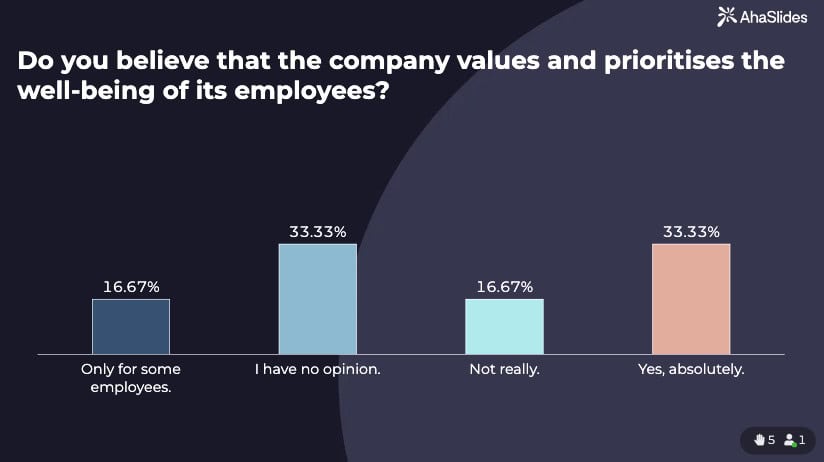
چرا این موضوع مهم است؟ برگهی کار موقعیتیابی شما مشخص میکند که متخصصان منابع انسانی در «مشارکت و بازخورد کارکنان» و «ایجاد فضاهای امن برای بحث صادقانه» با مشکل مواجه هستند. سوالات مربوط به رفاه ذاتاً حساس هستند - کارکنان میترسند که اگر به فرسودگی شغلی اعتراف کنند، ضعیف یا غیرمتعهد به نظر برسند. نظرسنجیهای ناشناس تعاملی این مانع را از بین میبرند.
رضایت کلی
سوال آخر: ۴۶. در مقیاس ۱ تا ۱۰، چقدر احتمال دارد که این شرکت را به عنوان یک محل کار عالی توصیه کنید؟ (امتیاز خالص مروجان کارمندان)
رویکرد تعاملی:
- پیگیری بر اساس نتایج: اگر امتیازها پایین است، فوراً بپرسید «چه چیزی را میتوانیم تغییر دهیم تا امتیاز شما را بهبود بخشیم؟»
- eNPS را به صورت بلادرنگ نمایش دهید تا رهبری، احساسات را فوراً ببیند.
- از نتایج برای پیشبرد گفتگوی شفاف در مورد بهبودهای سازمانی استفاده کنید
چگونه با AhaSlides یک نظرسنجی رضایت شغلی مؤثر انجام دهیم
مرحله 1: قالب خود را انتخاب کنید
گزینه الف: پخش زنده در طول جلسات عمومی
- ۸ تا ۱۲ سوال کلیدی را در جلسات سهماهه شورای شهر مطرح کنید
- برای موضوعات حساس از حالت ناشناس استفاده کنید
- نتایج را فوراً با گروه در میان بگذارید
- مناسب برای: ایجاد اعتماد، اقدام فوری، حل مسئله مشارکتی
گزینه ب: خودآموز اما تعاملی
- اشتراکگذاری لینک ارائه که کارمندان بتوانند در هر زمان به آن دسترسی داشته باشند
- شامل تمام ۴۶ سوال سازماندهی شده بر اساس دسته بندی
- یک مهلت برای تکمیل تعیین کنید
- مناسب برای: جمعآوری جامع دادهها، زمانبندی انعطافپذیر
گزینه ج: رویکرد ترکیبی (توصیه شده)
- ۵ تا ۷ سوال مهم را به عنوان نظرسنجیهای خودآموز ارسال کنید
- نتایج و سه نگرانی اصلی را در جلسه بعدی تیم به صورت زنده ارائه دهید
- از پرسش و پاسخ زنده برای بررسی عمیقتر مسائل استفاده کنید
- بهترین برای: حداکثر مشارکت با بحث معنادار
مرحله 2: نظرسنجی خود را در AhaSlides تنظیم کنید
ویژگی های مورد استفاده:
- مقیاس های رتبه بندی برای سطوح رضایت
- نظرسنجی های چند گزینه ای برای سوالات ترجیحی
- ابرهای کلمه ای برای تجسم مضامین مشترک
- پرسش و پاسخ آزاد برای اینکه کارمندان بتوانند سوالات ناشناس بپرسند
- حالت ناشناس برای تأمین امنیت روانی
- نمایش نتایج زنده برای نشان دادن شفافیت
نکته برای صرفهجویی در زمان: از مولد هوش مصنوعی AhaSlides برای ایجاد سریع نظرسنجی خود از این لیست سوالات استفاده کنید، سپس آن را برای نیازهای خاص سازمان خود سفارشی کنید.
مرحله ۳: هدف را بیان کنید
قبل از شروع نظرسنجی، موارد زیر را توضیح دهید:
- چرا این کار را انجام میدهید (نه فقط به این دلیل که «زمان بررسیهای سالانه فرا رسیده است»)
- نحوه استفاده از پاسخها
- اینکه پاسخهای ناشناس واقعاً ناشناس هستند
- چه زمانی و چگونه نتایج را به اشتراک میگذارید و اقدام میکنید
اسکریپت اعتمادسازی: «ما میخواهیم بفهمیم که شما واقعاً در مورد کار کردن در اینجا چه احساسی دارید. ما از نظرسنجیهای تعاملی ناشناس استفاده میکنیم زیرا میدانیم که نظرسنجیهای سنتی بازخورد صادقانه شما را ثبت نمیکنند. پاسخهای شما بدون نام نمایش داده میشوند و ما نتایج را با هم مورد بحث قرار خواهیم داد تا به طور مشترک راهحلهایی را توسعه دهیم.»
مرحله ۴: ارائه زنده (در صورت وجود)
ساختار جلسه:
- مقدمه (۲ دقیقه): هدف و ناشناس بودن را توضیح دهید
- سوالات نظرسنجی (۱۵-۲۰ دقیقه): نظرسنجیها را یکی یکی ارائه دهید و نتایج زنده را نشان دهید
- بحث (۱۵-۲۰ دقیقه): فوراً به نگرانیهای اصلی رسیدگی کنید
- برنامهریزی عملیاتی (۱۰ دقیقه): به مراحل بعدی مشخص متعهد شوید
- پرسش و پاسخ تکمیلی (۱۰ دقیقه): امکان پرسشهای ناشناس در فضای باز
نوک طرفدار: وقتی نتایج حساسی ظاهر میشوند (مثلاً ۷۰٪ افراد، ارتباط با رهبری را ضعیف ارزیابی میکنند)، فوراً آنها را تصدیق کنید: «این بازخورد مهمی است. بیایید در مورد اینکه «ارتباط ضعیف» برای شما به چه معناست، بحث کنیم. از پرسش و پاسخ برای به اشتراک گذاشتن نمونههای خاص به صورت ناشناس استفاده کنید.»
مرحله ۵: بر اساس نتایج عمل کنید
اینجاست که نظرسنجیهای تعاملی مزیت رقابتی ایجاد میکنند. زیرا شما در طول مکالمات زنده بازخورد جمعآوری کردهاید:
- کارمندان قبلاً نتایج را دیدهاند
- شما به طور عمومی متعهد به انجام اقداماتی شدهاید
- پیگیری مورد انتظار و قابل مشاهده است
- اعتماد زمانی ایجاد میشود که به وعدهها عمل شود
الگوی برنامه عملیاتی:
- نتایج دقیق را ظرف ۴۸ ساعت به اشتراک بگذارید
- ۳ حوزه برتر برای بهبود را شناسایی کنید
- تشکیل گروههای کاری برای تدوین راهکارها
- پیشرفت را ماهانه گزارش دهید
- ۶ ماه دیگر برای سنجش میزان بهبود، دوباره بررسی کنید
چرا نظرسنجیهای تعاملی بهتر از فرمهای سنتی عمل میکنند؟
با توجه به نیازهای سازمانی خود، شما باید:
- «سنجش میزان مشارکت کارکنان در طول طرحهای منابع انسانی»
- «جلسات پرسش و پاسخ ناشناس را در شهرداریها تسهیل کنید»
- «جمعآوری نظرات کارمندان با استفاده از ابرهای کلمات و نظرسنجیهای زنده»
- «فضاهای امنی برای بحث صادقانه ایجاد کنید»
ابزارهای نظرسنجی سنتی مانند Google Forms یا SurveyMonkey نمیتوانند این تجربه را ارائه دهند. آنها دادهها را جمعآوری میکنند، اما گفتگو ایجاد نمیکنند. آنها پاسخها را جمعآوری میکنند، اما اعتماد ایجاد نمیکنند.
پلتفرمهای تعاملی مانند AhaSlides جمعآوری بازخورد را از یک تمرین بوروکراتیک به یک گفتگوی معنادار تبدیل میکنند. که در آن:
- کارمندان اهمیت صدای خود را در لحظه میبینند
- رهبران تعهد فوری خود را به گوش دادن نشان میدهند
- ناشناس بودن ترس را از بین میبرد در حالی که شفافیت اعتماد ایجاد میکند
- بحث منجر به راهحلهای مشارکتی میشود
- دادهها به یک عامل شروع کننده گفتگو تبدیل میشوند، نه گزارشی که در کشو قرار میگیرد
نکات کلیدی
✅ نظرسنجیهای رضایت شغلی ابزارهای استراتژیک هستندنه چکباکسهای مدیریتی. آنها نشان میدهند که چه چیزی باعث تعامل، حفظ و عملکرد میشود.
✅ نظرسنجیهای تعاملی نتایج بهتری به همراه دارند نسبت به اشکال سنتی - نرخ پاسخ بالاتر، بازخورد صادقانهتر و فرصتهای بحث فوری.
✅ ناشناس بودن به علاوه شفافیت امنیت روانی لازم برای بازخورد واقعی را ایجاد میکند. کارمندان وقتی میدانند پاسخها ناشناس هستند اما میبینند که رهبران در حال اقدام هستند، صادقانه پاسخ میدهند.
✅ ۴۶ سوال این راهنما ابعاد حیاتی را پوشش میدهند. رضایت شغلی: محیط، مسئولیتها، رهبری، رشد، حقوق و دستمزد، روابط و رفاه.
✅ نتایج بلادرنگ، اقدام فوری را ممکن میسازد. وقتی کارمندان میبینند که بازخوردشان فوراً به صورت تصویری نمایش داده میشود و به طور علنی مورد بحث قرار میگیرد، احساس میکنند که شنیده شدهاند، نه اینکه فقط مورد نظرسنجی قرار گرفتهاند.
✅ ابزارها اهمیت دارند. پلتفرمهایی مانند AhaSlides با نظرسنجیهای زنده، ابرهای کلمات، پرسش و پاسخ ناشناس و نمایش نتایج در لحظه، پرسشنامههای ایستا را به گفتگوهای پویایی تبدیل میکنند که باعث تغییر سازمانی میشوند.
منابع:




